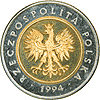Polish złoty
| Polish złoty | |||||
|---|---|---|---|---|---|
| Polski złoty (Polish) | |||||
|
|||||
| ISO 4217 | |||||
| Code | PLN | ||||
| Denominations | |||||
| Subunit | |||||
| 1⁄100 | Grosz | ||||
| Plural | The language(s) of this currency belong(s) to the Slavic languages. There is more than one way to construct plural forms. | ||||
| Symbol | zł | ||||
| Grosz | gr | ||||
| Banknotes | 10zł, 20zł, 50zł, 100zł, 200zł, 500zł | ||||
| Coins | 1gr, 2gr, 5gr, 10gr, 20gr, 50gr, 1zł, 2zł, 5zł | ||||
| Demographics | |||||
| User(s) | Poland | ||||
| Issuance | |||||
| Central bank | National Bank of Poland | ||||
| Website | www |
||||
| Mint | Mennica Polska | ||||
| Website | www |
||||
| Valuation | |||||
| Inflation | −0.5% | ||||
| Source | (July 2016) | ||||
The złoty (pronounced [ˈzwɔtɨ];sign: zł; code: PLN), which literally means "golden", is the currency of Poland. The modern złoty is subdivided into 100 groszy (singular: grosz; alternative plural form: grosze). The recognized English form of the word is zloty, plural zloty or zlotys. The currency sign, zł, is composed of the Polish lower-case letters z and ł (Unicode: U+007A z LATIN SMALL LETTER z & U+0142 ł LATIN SMALL LETTER L WITH STROKE).
As a result of inflation in the early 1990s, the currency underwent redenomination. Thus, on January 1, 1995, 10,000 old złotych (PLZ) became one new złoty (PLN). Since then, the currency has been relatively stable, with an exchange rate fluctuating between 3 and 4 złoty for a United States dollar.
The predecessors of the złoty were the Polish mark (grzywna) and a kopa. Grzywna was a currency that was equivalent to approximately 210 g of silver, in the 11th century. It was used until sometime in the 14th century, when it gave way to the Kraków grzywna (approximately 198 g of silver). At the same time, first as the complement to grzywna, and then as the main currency, came a grosz and a kopa. Poland made grosz as the imitation of the Prague groschen; the idea of kopa came from the Czechs as well. A grzywna was worth 48 groszy; a kopa cost 60 groszy.
The złoty (golden) is a traditional Polish currency unit dating back to the late Middle Ages. Initially, in the 14th and 15th centuries, the name was used for all kinds of foreign gold coins used in Poland, most notably Venetian and Hungarian ducats, (however, in Ukraine, Volyn and Galicia, the name for them were the золотий - golden). One złoty at the very beginning of their introduction cost 12–14 groszy; however, groszy had less and less silver as time passed. In 1496 the Sejm approved the creation of a national currency, the złoty, and its value was set at 30 groszy, a coin minted since 1347 and modelled on the Prague groschen, and a ducat (florin), whose value was 1 1⁄2 złoty. The 1:30 proportion stayed ( 1⁄2 of a kopa), but the grosz became cheaper and cheaper, because the proportion of silver in the coin alloy diminished by time. In the beginning of the 16th century, 1 złoty was worth 32 groszy; by the middle of the same century it was 50 groszy; by the reign of Sigismund III Vasa 1 złoty was worth 90 groszy, while a ducat was worth 180 groszy.
...
Wikipedia


